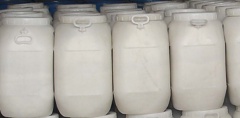Calcium Hypochlorite
| Infobox on Calcium Hypochlorite | |
|---|---|
| Example of Calcium Hypochlorite |  |
| Facts | |
| Origin | - |
| Stowage factor (in m3/t) | - |
| Humidity / moisture | 3% max. |
| Ventilation | - |
| Risk factors | See text |
Calcium Hypochlorite
Contents
Description
Calcium hypochlorite is a chemical compound with formula Ca(ClO)2. It is white or yellowish solid (powder, granules or tablets), having a chlorine-like odour; soluble in water.
An oxidising agent with (strong) decomposing and self-reactive characteristics with a high track record of having caused very serious on-board fires and explosions.
Application
Calcium hypochlorite is used for the disinfection of drinking water or swimming pool water. It is used as a sanitizer in outdoor swimming pools in combination with a cyanuric acid stabilizer, which reduces the loss of chlorine due to ultraviolet radiation. The calcium content hardens the water and tends to clog up some filters; hence, some products containing calcium hypochlorite also contain anti-scaling agents.
Calcium hypochlorite is also an ingredient in bleaching powder, used for bleaching cotton and linen. It is also used in bathroom cleaners, household disinfectant sprays, moss and algae removers, and weedkillers.
In addition, calcium hypochlorite may be used to manufacture chloroform.
Bleaching powder is used also in sugar industry for bleaching sugar cane juice before its crystallization.
Shipment /Storage
Calcium Hypochlorite has been the cause of numerous fires, explosions and disasters, most of which could be attributed to one of the following causes or combination of causes:
- Stuffing of damaged receptacles
- Improper stowage and consequent damage to receptacles in heavy weather
- Improper segregation from goods such as combustible solids or liquids and like colors, dyes, oils and textiles, non combustible liquids containing water, ammonium compounds sal ammoniac, etc.
- Impact or friction during conventional stuffing and or cargo operations
- Contact with rust after spillage of contents
- Decomposing nature of the product itself, the rate of which being heavily dependent on storage temperature and production characteristics.
When consolidating this substance in containers great care should be taken when selecting the co-load, and the container should be absolutely clean and dry.
Over the years the stability of this substance has much improved. It is now more and more replaced by the safer and more stable isocyanurates. In all circumstances the shipper shall deliver a document stating the percentage of free chlorine. For all shipments of calcium hypochlorite containing more than 70% active chlorine, it is recommended that special clearance be obtained.
Meanwhile the international group of P&I clubs has informed its members that shipments of Calcium Hypochlorite have been loaded on board vessels under different names, which has lead to some of the shipments not being declared as dangerous cargo. Below is a list of presently known synonyms for products that are Calcium Hypochlorite or products related to Calcium Hypochlorite.
In 2016 CINS and International Group of P&I Clubs published an important Guideline for the carriage of calcium hypochlorite in containers (see link under "Risk factors".
Depending on the exact chemical composition of the product it may or may not become unstable at temperatures encountered in the ship's hold, and therefore STOWAGE CATEGORY "D", ON DECK STOW ONLY, SHADED FROM DIRECT SUNLIGHT, AWAY FROM HEAT is required:
- B-K Powder
- Bleaching Powder
- Bleaching Powder, containing 39% or less chlorine (DOT)
- Calcium Chlorohydrochlorite
- Calcium Hypochloride
- Calcium Hypochlorite
- Calcium Oxychloride
- Caporit
- CCH
- Chloride of Lime (DOT)
- Chlorinated Lime (DOT)
- HTH
- Hy-Chlor
- Hypochlorus Acid, Calcium Salt
- Lime Chloride
- Lo-Bax
- Losantin
- Perchloron
- Pittchlor
- Pittcide
- Pittclor
- Sentry
It may also be shipped as water purification tablets and swimming pool cleanser.
Due to recent incidents where lack of blocking and bracing has resulted in damage of reefers it is now MANDATORY that customers provide a report from either an independent surveyor or a certified in-house survey.
Due to recent incidents of damaged reefers due to improper blocking and bracing of Calcium Hypochlorite, it is now MANDATORY that customers provide a report from either an independent surveyor or a certified in-house surveyor and report, viz.
- Drums have to be stowed in upright positions only (Not on side).
- Only PLASTIC drums have to be loaded in refrigerated container. Bags, IBC's and bulk packagings are not allowed.
- Drum size should not be larger than 45 kgs net weight.
- Were drums stowed in containers using multiple tier method? If yes, strong dunnage or plywood should have been inserted between each tier of drums to ensure bottom tier not being crushed.
- Cargo transport units should be shaded from direct sunlight and stowed away from sources of heat.
- Packages in cargo transport units should be stowed so as to allow for adequate air circulation throughout the cargo.
- Separated from powdered metals and their compounds, ammonium compounds, cyanides, hydrogen peroxides and liquid organic substances.
Risk Factors
Calcium hypochlorite is liable to exothermic decomposition at elevated temperatures. This condition may lead to fire or explosion. Decomposition can be initiated by heat or by impurities (e.g. powdered metals (iron, manganese, cobalt, magnesium) and their compounds).
Liable to heat slowly.
Reacts with acids, evolving chlorine, an irritating, corrosive and toxic gas. In the presence of moisture, corrosive to most metals.
Dust irritates mucous membranes.
See also:
http://www.cinsnet.com/wp-content/uploads/2016/01/Calcium-Hypochlorite-Guidelines-CINS-IGPI-May-2016.pdf
http://www.chemicalland21.com/industrialchem/inorganic/CALCIUM%20HYPOCHLORITE.htm











